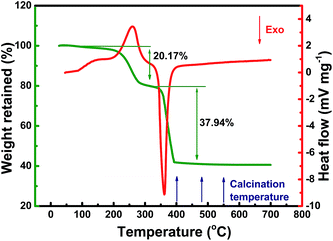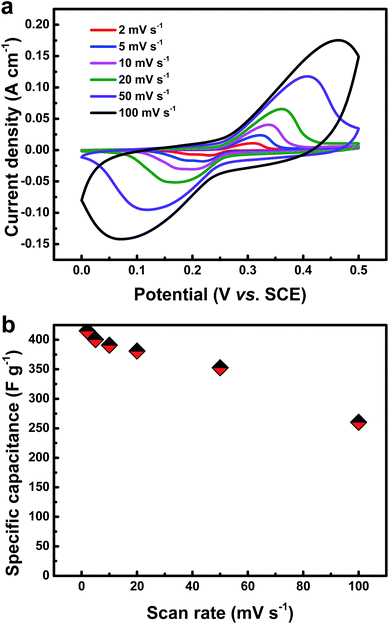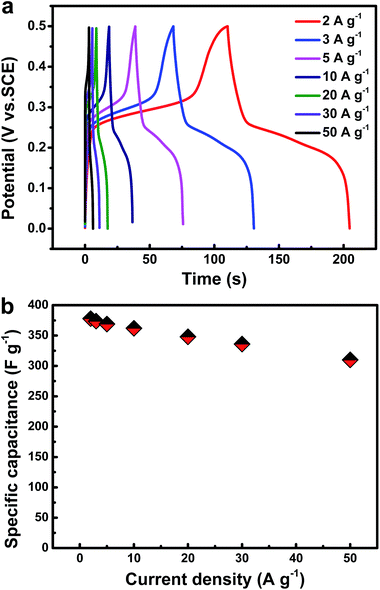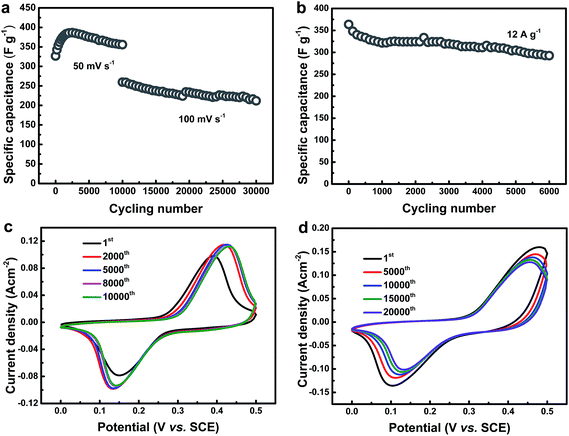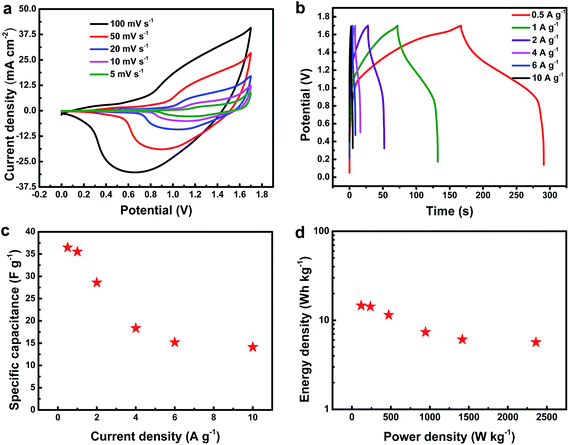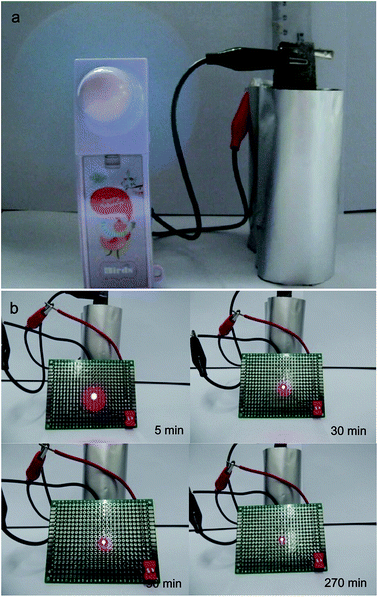Nickel oxide nanopetal-decorated 3D nickel network with enhanced pseudocapacitive properties†
Guanhua Chenga,
Qingguo Baia,
Conghui Sia,
Wanfeng Yanga,
Chaoqun Donga,
Hao Wanga,
Yulai Gaob and
Zhonghua Zhang*ab
aKey Laboratory for Liquid-Solid Structural Evolution and Processing of Materials (Ministry of Education), School of Materials Science and Engineering, Shandong University, Jingshi Road 17923, Jinan 250061, P. R. China. E-mail: zh_zhang@sdu.edu.cn
bShanghai Key Laboratory of Modern Metallurgy and Materials Processing, Shanghai University, 200072 Shanghai, P. R. China
First published on 23rd January 2015
Abstract
Metal oxides possess high theoretical specific capacitance, but their pseudocapacitive properties are restricted by the poor electronic conductivity. Here we present a strategy to synthesize a three-dimensional binder/conducting agent-free nickel oxide (NiO) electrode through the combination of anodization with calcination. The NiO electrode is composed of a 3D conductive nickel network decorated with nanopetal-like NiO arrays. The influence of calcination temperature has been investigated, with respect to the microstructure and pseudocapacitive properties of the NiO electrodes. The NiO electrode demonstrates great electrochemical properties, especially remarkable rate capability (82% retention of the highest value for the 25-fold enhanced current density) and cycling stability (good capacitance retention after 30![[thin space (1/6-em)]](https://www.rsc.org/images/entities/char_2009.gif) 000 cycles). Moreover, an asymmetric supercapacitor has been assembled using NiO as the positive electrode and activated carbon (AC) as the negative electrode. The NiO//AC supercapacitor presents excellent cycling stability (91.3% retention after 10
000 cycles). Moreover, an asymmetric supercapacitor has been assembled using NiO as the positive electrode and activated carbon (AC) as the negative electrode. The NiO//AC supercapacitor presents excellent cycling stability (91.3% retention after 10![[thin space (1/6-em)]](https://www.rsc.org/images/entities/char_2009.gif) 000 cycles), and could power a mini fan as well as a commercial red LED for more than 270 min.
000 cycles), and could power a mini fan as well as a commercial red LED for more than 270 min.
1. Introduction
Nickel compounds have been extensively investigated for decades due to their promising and widespread applications in different areas such as catalysts,1 energy storage,2–5 magnetic materials6 and sensors.7,8 Nickel oxide as a semiconductor and antiferromagnetic material is also used in various fields. Owing to its low cost, environmental friendliness and high theoretical specific capacitance (2584 F g−1 within 0.5 V), NiO is considered to be a potential candidate for electrode materials in redox electrochemical capacitors.9,10 However, there are still some challenges in practical applications, for example, tedious and time-consuming preparation techniques, high resistivity, restricted intrinsic capacitance and poor cyclic performance.The fabrication methods of NiO can be mainly divided into two types based on the procedures. One is to synthesize NiO directly, such as oxidation.11 The other is a two-step approach, which means fabricating precursors firstly, such as hydrothermal process,12 soft chemistry,13 chemical bath deposition,14 and microwave-assisted fabrication15 and then obtaining NiO by further processing. The morphology of the precursors is of all kinds, such as nanoparticles, films, 3D networks and so on. Nickel oxalate and nickel hydroxide are the most common precursors for fabricating nickel oxide. There are many methods to synthesize the precursors, but the time-consuming and complicated processing technology narrows their practical applications. Moreover, the as-prepared nanoparticles need to be mixed with binder and conducing agent and then be pressed onto current collectors, while the ones derived from the deposition method suffer from weak adhesion.5,16,17 The close relationship between precursors and products has been clearly exemplified from the recent researches on calcination of precursors into nanoporous NiO and the concept of precursor controlled synthesis of NiO nanostructures is further inspired.13 That is to say, an appropriate fabrication of precursor is crucial to the microstructure and properties of NiO.
Anodization has been widely investigated in order to form nanostructured oxide layer onto different metals, such as anodic aluminum oxide (AAO),18 TiO2,19 WO3,20 NbO21 and ZrO2.22 The anodized products growing on the substrate directly demonstrate outstanding performance in various fields. Furthermore, anodization is a facile, time-saving and mass-produced method. In the previous work, we have found that nickel foam could be anodized to form nanostructured nickel oxalate in oxalic acid solutions.23
In the present work, anodization has been used to fabricate the nickel oxalate precursor which grows on the skeleton surface of nickel foam. Then nanopetal-like NiO decorated nickel foam could be obtained through calcination of the precursor. The influence of calcination temperature on the microstructure and cycling stability of the obtained NiO has also been investigated. The as-prepared NiO demonstrates great electrochemical pseudocapacitive properties, especially remarkable rate capability and cycling stability. Moreover, an asymmetric supercapacitor has been constructed using nickel oxide as the positive electrode and activated carbon as the negative electrode. The asymmetric supercapacitor presents excellent cycling stability and could even power a mini fan as well as a commercial red LED for quite a long time.
2. Experimental
2.1 Preparation of nickel oxalate precursor and nanostructured NiO
The NiO electrode was synthesized by a two-step approach. The precursor of nanostructured nickel oxalate was fabricated through anodizing commercial nickel foam in an oxalic acid solution using a two-electrode cell, following by thermal decomposition in a resistance furnace. The nickel foam was degreased by sonicating in acetone, rinsed with deionized water and dried in air. After that, the nickel foam was cut into pieces and sealed to ensure the working area of 2 cm × 2 cm. Anodization was carried out in a 0.3 M oxalic acid aqueous solution, the working voltage was a constant 50 V, and temperature was kept at −5 °C for 10 min with the nickel foam as the anode, using a DC stabilized power supply (Wenhua, China). After being rinsed with deionized water, anhydrous alcohol and dried in air, the calcination of the as-obtained precursor was carried out at different temperatures (400, 480 and 550 °C) for 45 min in air. Thus the nanostructured NiO decorated nickel foam was obtained.2.2 Characterization
The microstructure of the as-prepared samples was characterized by X-ray diffraction (XRD, RigakuD/max-rB) with Cu Kα radiation, scanning electron microscopy (SEM, LEO 1530 VP) and transmission electron microscopy (TEM, FEI Tecnai G2). Selected-area electron diffraction (SAED) was performed to document the crystalline nature of the samples. TEM specimens were prepared by ion milling at 5 kV (Gatan ion mill). In addition, thermogravimetric analysis (TGA) and differential scanning calorimetry (DSC) experiments were carried out in air at a heating rate of 20 °C min−1.2.3 Electrochemical measurements
Electrochemical measurements were performed using a potentiostat (CHI660E, Shanghai, Chenhua) with a three-electrode electrochemical cell containing 2 M KOH aqueous solution as the electrolyte at room temperature. The prepared NiO was used as the working electrode, the bright Pt foil as the counter electrode and an SCE electrode (in saturated KCl solution) as the reference electrode. Cyclic voltammetry (CV) and galvanostatic charge/discharge were tested.An asymmetric supercapacitor was assembled using the NiO as the positive electrode and an activated carbon (AC) electrode as the negative electrode. The cellulose paper was used as the separator. The electrolyte was the 2 M KOH aqueous solution. The AC electrode was prepared as follows. Firstly, AC (TF-B520), TIMCAL SUPER C45 conductive carbon black and polyvinylidene fluoride (PVDF) were mixed homogeneously with a mass ratio of 8![[thin space (1/6-em)]](https://www.rsc.org/images/entities/char_2009.gif) :
:![[thin space (1/6-em)]](https://www.rsc.org/images/entities/char_2009.gif) 1
1![[thin space (1/6-em)]](https://www.rsc.org/images/entities/char_2009.gif) :
:![[thin space (1/6-em)]](https://www.rsc.org/images/entities/char_2009.gif) 1. Appropriate N-methyl pyrrolidone (NMP) was added into the mixture as a solvent to make a slurry which was then pressed onto a nickel foam. Finally, the as-prepared electrode was dried at 80 °C for 5 h to remove the solvent. Electrochemical measurements of the NiO//AC asymmetric supercapacitor were also carried out using the CHI 660E potentiostat, including cyclic voltammetry, galvanostatic charge/discharge and electrochemical impedance spectroscopy (EIS). EIS was performed in a frequency range from 0.01 Hz to 100 kHz with a 5 mV amplitude at open circuit potential.
1. Appropriate N-methyl pyrrolidone (NMP) was added into the mixture as a solvent to make a slurry which was then pressed onto a nickel foam. Finally, the as-prepared electrode was dried at 80 °C for 5 h to remove the solvent. Electrochemical measurements of the NiO//AC asymmetric supercapacitor were also carried out using the CHI 660E potentiostat, including cyclic voltammetry, galvanostatic charge/discharge and electrochemical impedance spectroscopy (EIS). EIS was performed in a frequency range from 0.01 Hz to 100 kHz with a 5 mV amplitude at open circuit potential.
3. Results and discussions
Fig. S1a† shows the XRD pattern of the anodized nickel foam, which confirms the formation of nickel oxalate hydrate (NiC2O4·2H2O) on nickel foam. Nickel oxalate blocks are diamond-like and several hundred nanometers in size, which in situ grow on the surface of skeletons of nickel foam (Fig. S1b and c†). To determine the decomposition temperature, we have studied the thermal behavior of the nickel oxalate precursor. Fig. 1 shows the TG–DSC curve of the nickel oxalate. There are two weight loss steps in the temperature range of 80–300 °C and 300–400 °C. The initial weight loss of ∼20.17% at 80–300 °C, which is accompanied by a broad endothermic peak at 260 °C, is attributed to the removal of crystal water. Subsequently, the second weight loss of about 30.94% occurs in the temperature range of 300–400 °C. A sharp exothermic peak at 361 °C is owing to the further decomposition of the nickel oxalate, corresponding to the transformation from NiC2O4 to NiO accompanying by the release of CO2. By measuring changes in the weight of the anodized samples before and after calcination, we could obtain the loading of NiO on the nickel foam in the light of the involved phase transformation (from NiC2O4·2H2O to NiO) during the calcination process (more calculation details are supported in the ESI†). Moreover, the calculated values are in accordance with the TG results.According to the TG–DSC curve, the as-anodized samples were calcined at different temperatures (400, 480 and 550 °C), as highlighted by arrows in Fig. 1. Fig. 2 demonstrates the XRD patterns of the anodized nickel foam samples calcined at different temperatures. It is clear that the nickel oxalate transforms into NiO after calcination. The diffraction peaks at 37.2°, 43.2°, 62.9°, 75.4° and 79.4° can be indexed to (111), (200), (220), (311) and (222) planes of NiO (PDF# 47-1049). The nickel substrate was detected at 44.5° for (111) plane, 51.8° for (200) plane and 76.4° for (220) plane (PDF# 65-2865). Fig. 2b apparently shows that the intensity of the NiO diffraction peaks is enhanced and at the same time the peaks narrow with the increasing calcination temperature, which indicates the coarsening of the grains. The average value of grain size can be calculated by the Scherrer's formula:
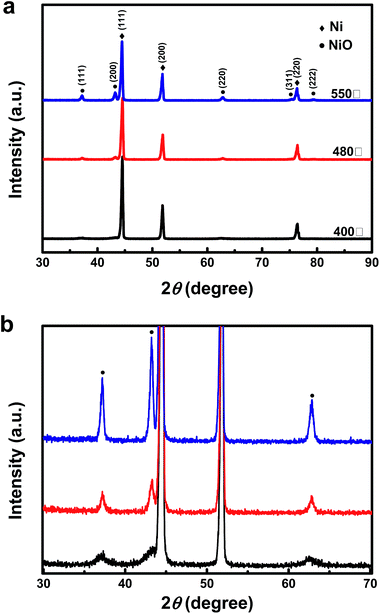 | ||
| Fig. 2 XRD patterns of the NiO decorated nickel foam samples obtained by calcination of the anodized nickel foam at 400, 480 and 550 °C. | ||
Fig. 3 presents the SEM images of the NiO electrodes obtained through calcination of the anodized nickel foam at different temperatures. Fig. 3b shows the nanostructured NiO arrays on the skeleton surface of nickel foam, while Fig. 3a, c, and d demonstrates the detailed nanostructures of NiO obtained at different temperatures. The nanostructured NiO is nanopetal-like, and in some areas, the NiO nanopetals gather together into a blooming flower-like structure (Fig. 3a and c). The length of the petals is around 1–1.5 μm, and the side length of the quadrilateral cross section is 200–500 nm. Certainly, the morphologies and sizes of different samples are diverse depending on the calcination temperature. More details are shown in Fig. S2–4.† Calcination at a higher temperature apparently results in an increase in the size of grains. As a matter of fact, the grains can be clearly seen from the high-magnification SEM images for the samples calcined at higher annealing temperatures (Fig. 3d, S3 and S4†). The grain size of the NiO calcined at 480 and 550 °C is about 15–25 nm and 35–45 nm, respectively. In comparison, it is difficult to discern the grains in the sample annealed at 400 °C (Fig. 3a). In addition, the NiO nanopetals collapse with the increasing calcination temperature, especially for the sample calcined at 550 °C (Fig. S4†). Through the combination of anodization with subsequent calcination, thus we obtained the NiO electrodes composed of three-dimensional continuous nickel networks decorated with array-like NiO nanopetals.
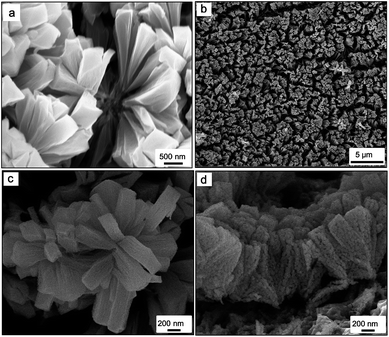 | ||
| Fig. 3 SEM images of the NiO electrodes obtained through calcination of the anodized nickel foam at (a) 400 °C, (b and c) 480 °C and (d) 550 °C. | ||
Some samples were selected to perform TEM characterization. Fig. 4 shows the TEM results of the NiO electrode obtained through calcination at 400 °C. The TEM image clearly shows the morphology of the NiO nanopetals (Fig. 4a), which coincides with the SEM images. The SAED (selected area, ∼200 nm in diameter) pattern exhibits polycrystalline rings (inset of Fig. 4a), suggesting the nanocrystalline nature of the NiO nanopetals. The diffraction rings can be readily indexed as (111), (200), (220), (311) and (222) crystal planes of the cubic NiO phase, which is in accordance with the XRD results. Fig. 4b presents the lattice-resolved high-resolution TEM (HRTEM) image of the NiO nanopetal, in which a d spacing of 2.45 Å is indexed for the (111) crystal plane of NiO. The grain size roughly calculated from several HRTEM images is about 5.6 nm, which well accords with the result calculated by the Scherrer's formula.
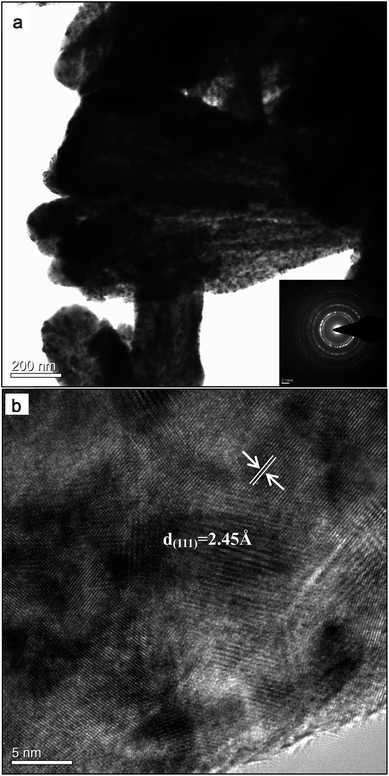 | ||
| Fig. 4 (a) TEM and (b) HRTEM images of the NiO electrode obtained through calcination of the anodized nickel foam at 400 °C. Inset in (a): corresponding SAED pattern. | ||
Fig. 5 shows the Brunauer–Emmett–Teller (BET) surface area of the NiO electrode calcined at 480 °C measured by N2 adsorption–desorption isotherms at 77 K. From the shape of the isotherms, the samples correspond well to the type IV curve with a hysteresis loop, indicating that the sample is a typical mesoporous material. According to the adsorption–desorption isotherms, the specific surface of the NiO calcined at 480 °C is calculated to be 29.34 m2 g−1 (normalized by the activated mass of the electrode). The BET surface area of the NiO electrode calcined at 400 and 550 °C were also measured to be 68.29 and 13.72 m2 g−1, respectively (normalized by the activated mass of the electrode). That is to say grain coarsening at a higher calcination temperature can lead to a clear decrease of the specific surface.
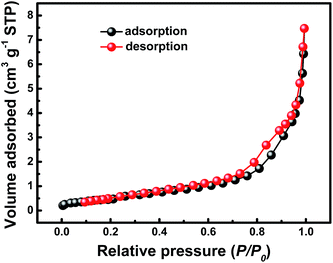 | ||
| Fig. 5 N2 adsorption–desorption isotherm of the NiO calcined at 480 °C (based on the total mass of the electrodes). | ||
As the microstructure is a crucial factor for the pseudocapacitive performance of NiO electrode, the CV measurements of the NiO electrodes obtained at different temperatures (400, 480 and 550 °C) were carried out to evaluate their cycling stability and to further determine the most appropriate calcination temperature. Fig. S5† shows the cycling stability results of the NiO electrodes obtained at different temperatures. The specific capacitance of the NiO electrode obtained at 400 °C is 231.7 F g−1, reaches to the maximum value of 490.7 F g−1 at the 8000th cycle and decreases to 422.7 F g−1 at the 12![[thin space (1/6-em)]](https://www.rsc.org/images/entities/char_2009.gif) 500th cycle. While the sample obtained at 480 °C possesses a specific capacitance of around 326.6 F g−1 at the first cycle, increasing to 385.7 F g−1 at the 2000th cycle and decreasing to 355.8 F g−1 after 10
500th cycle. While the sample obtained at 480 °C possesses a specific capacitance of around 326.6 F g−1 at the first cycle, increasing to 385.7 F g−1 at the 2000th cycle and decreasing to 355.8 F g−1 after 10![[thin space (1/6-em)]](https://www.rsc.org/images/entities/char_2009.gif) 000 cycles. As to the NiO electrode obtained at 550 °C, the specific capacitance is 213.5 F g−1 at the beginning, slowly increases to 240.2 F g−1 during the following 2000 cycles and decreases to 226.6 F g−1 at the 8000th cycle. In contrast, the NiO electrode obtained at 480 °C demonstrates a better cycling stability (compared to the electrode obtained at 400 °C) with a higher specific capacitance (compared to the electrode obtained at 550 °C). Obviously, the NiO obtained at a relatively low temperature exhibits a higher specific capacitance than their counterparts. This may be attributed to the grain coarsening and deterioration of NiO arrays with the increasing calcination temperature (Fig. 2, 3 and S2–4†), as well as the decrease in specific surface area (confirmed by the BET measurements in Fig. 5). The NiO electrode obtained at 550 °C shows a good cycling performance which may be due to the enhanced structure stability. Indeed, the phenomenon that the specific capacitance of the electrode materials increased in the initial cycling stability tests is very common, and the reason is generally attributed to the “activation process”.24–26 Herein, as the calcination temperature increased, the sharpening of diffraction peaks could be observed (Fig. 2b), which indicates an increase in the degree of crystallization. At the same time, the crystallite growth during the calcination process results in an increase in the average crystallite size. Fig. S5† shows that the specific capacitance of the NiO electrode obtained at a lower calcination temperature needs longer further cycles to get the maximum value and more easily decreases. That is to say, the crystallinity of the electrodes has great influence on the electrochemical stability. Owing to the smaller crystallite size and lower crystallinity, the electrode obtained at 400 °C needs more CV cycles to become stable. When redox reactions occur on both the surface and near-surface of active NiO nanopetals, the crystallites would reconstruct/grow accompanying the activation of the electrode. After numerous harsh redox reactions, the destruction of NiO nanopetals would give rise to the decrease of specific capacitance with further increasing CV cycles. In comparison, the electrode obtained at higher temperature (480 or 550 °C) needs less CV cycles to reach stabilization due to higher crystallinity. In order to meet the requirement of practical applications, both high specific capacitance and excellent cycling stability are pursued for high-performance electrode materials. Therefore, 480 °C was chosen as the optimal calcination temperature for the anodized nickel foam. And the electrochemical properties of the NiO electrode obtained at 480 °C were further probed in the following, including cyclic voltammetry, galvanostatic charge/discharge and cycling stability measurements.
000 cycles. As to the NiO electrode obtained at 550 °C, the specific capacitance is 213.5 F g−1 at the beginning, slowly increases to 240.2 F g−1 during the following 2000 cycles and decreases to 226.6 F g−1 at the 8000th cycle. In contrast, the NiO electrode obtained at 480 °C demonstrates a better cycling stability (compared to the electrode obtained at 400 °C) with a higher specific capacitance (compared to the electrode obtained at 550 °C). Obviously, the NiO obtained at a relatively low temperature exhibits a higher specific capacitance than their counterparts. This may be attributed to the grain coarsening and deterioration of NiO arrays with the increasing calcination temperature (Fig. 2, 3 and S2–4†), as well as the decrease in specific surface area (confirmed by the BET measurements in Fig. 5). The NiO electrode obtained at 550 °C shows a good cycling performance which may be due to the enhanced structure stability. Indeed, the phenomenon that the specific capacitance of the electrode materials increased in the initial cycling stability tests is very common, and the reason is generally attributed to the “activation process”.24–26 Herein, as the calcination temperature increased, the sharpening of diffraction peaks could be observed (Fig. 2b), which indicates an increase in the degree of crystallization. At the same time, the crystallite growth during the calcination process results in an increase in the average crystallite size. Fig. S5† shows that the specific capacitance of the NiO electrode obtained at a lower calcination temperature needs longer further cycles to get the maximum value and more easily decreases. That is to say, the crystallinity of the electrodes has great influence on the electrochemical stability. Owing to the smaller crystallite size and lower crystallinity, the electrode obtained at 400 °C needs more CV cycles to become stable. When redox reactions occur on both the surface and near-surface of active NiO nanopetals, the crystallites would reconstruct/grow accompanying the activation of the electrode. After numerous harsh redox reactions, the destruction of NiO nanopetals would give rise to the decrease of specific capacitance with further increasing CV cycles. In comparison, the electrode obtained at higher temperature (480 or 550 °C) needs less CV cycles to reach stabilization due to higher crystallinity. In order to meet the requirement of practical applications, both high specific capacitance and excellent cycling stability are pursued for high-performance electrode materials. Therefore, 480 °C was chosen as the optimal calcination temperature for the anodized nickel foam. And the electrochemical properties of the NiO electrode obtained at 480 °C were further probed in the following, including cyclic voltammetry, galvanostatic charge/discharge and cycling stability measurements.
Fig. 6 a shows the representative CV curves of the NiO electrode in the voltage window of 0 V to 0.5 V (vs. SCE) at various scan rates from 2 mV s−1 to 100 mV s−1. As can be seen, a pair of current peaks can be clearly identified from the CV curves, which are different from those of the electric double layer capacitance. These indicate that the two strong peaks correspond to the faradic oxidation/reduction reactions. According to the redox mechanism, the faradic reactions can be described by the following equation,27,28
| NiO + OH− ↔ NiOOH + e− |
In addition, the peak intensity increases with the increasing scan rate, but the CV curve still shows an obvious pair of redox peaks, suggesting good reversibility of the involved faradic reactions. Fig. 6b shows the calculated specific capacitance of the NiO electrode as a function of scan rates, using the following equation,29,30
| C = ∫(I dV)/(vmΔV) |
The specific capacitance reaches up to 415.2 F g−1 at 2 mV s−1. With increasing scan rate to 100 mV s−1, the specific capacitance decreases to 260.3 F g−1. This might result from the presence of inner active sites that cannot sustain the redox transition completely at higher scan rates, leading to low electrochemical utilization of NiO.31
Fig. 7a shows the galvanostatic charge/discharge profiles of the NiO electrode at current densities ranging from 2 A g−1 to 50 A g−1 in the voltage range from 0 V to 0.5 V (vs. SCE). A distinct voltage plateau can be observed in the charge and discharge curves, which is consistent with the CV measurements. All the charge/discharge profiles are symmetric, indicating excellently reversible redox reactions. The specific capacitance can also be calculated from the galvanostatic charge/discharge profiles by the following formula,32–34
| C = IΔt/mΔV |
As one of the most important factors for evaluating high performance electrode materials, the cycling stability of the NiO electrode was also measured by CV and galvanostatic charge/discharge. Fig. 8a shows the specific capacitance retention of the NiO electrode over 30![[thin space (1/6-em)]](https://www.rsc.org/images/entities/char_2009.gif) 000 CV cycles (10
000 CV cycles (10![[thin space (1/6-em)]](https://www.rsc.org/images/entities/char_2009.gif) 000 cycles at the scan rate of 50 mV s−1 and subsequent 20
000 cycles at the scan rate of 50 mV s−1 and subsequent 20![[thin space (1/6-em)]](https://www.rsc.org/images/entities/char_2009.gif) 000 cycles at 100 mV s−1). The specific capacitance at the scan rate of 50 mV s−1 in the first cycle is around 326.6 F g−1, increases to 385.7 F g−1 at the 2000th cycle, and decreases to 355.8 F g−1 after 10
000 cycles at 100 mV s−1). The specific capacitance at the scan rate of 50 mV s−1 in the first cycle is around 326.6 F g−1, increases to 385.7 F g−1 at the 2000th cycle, and decreases to 355.8 F g−1 after 10![[thin space (1/6-em)]](https://www.rsc.org/images/entities/char_2009.gif) 000 cycles. The specific capacitance could be retained as 92.2% of the maximum value. At the scan rate of 100 mV s−1, the initial specific capacitance is 259.6 F g−1 and decreases to 215.6 F g−1 (Fig. 8a), with a retention rate of 83.0% after 20
000 cycles. The specific capacitance could be retained as 92.2% of the maximum value. At the scan rate of 100 mV s−1, the initial specific capacitance is 259.6 F g−1 and decreases to 215.6 F g−1 (Fig. 8a), with a retention rate of 83.0% after 20![[thin space (1/6-em)]](https://www.rsc.org/images/entities/char_2009.gif) 000 cycles. The galvanostatic charge/discharge was measured at 12 A g−1 for the NiO electrode. The specific capacitance reaches up to 363.6 F g−1 and then decreases to 292.4 F g−1 after 6000 cycles, resulting in a total capacitance loss of 19.6% (Fig. 8b). Fig. 8c and d intuitively shows the typical CV curves after different cycles.
000 cycles. The galvanostatic charge/discharge was measured at 12 A g−1 for the NiO electrode. The specific capacitance reaches up to 363.6 F g−1 and then decreases to 292.4 F g−1 after 6000 cycles, resulting in a total capacitance loss of 19.6% (Fig. 8b). Fig. 8c and d intuitively shows the typical CV curves after different cycles.
Table 1 shows the specific capacitance and stability of some NiO and NiO composite electrodes.12,35–38 Compared to the NiO-based electrodes reported in the literature, the present NiO electrode displays the comparable specific capacitance at the similar charge/discharge current density. However, our sample demonstrates overwhelming advantage in cycling stability. It is well known that the cycling lifetime of metal oxides is limited because of gradual mechanical failure of the electrodes resulted from volumetric variation of the oxide phases during cycling.39 In our work, the nickel oxalate precursor in situ grew on the nickel foam results in the excellent interfacial contact between the NiO nanopetals and the substrate, as well as enhanced mechanical stability. Furthermore, the three dimensional structure of nickel foam not only acts as the current collector, but also functions as conductive pathway to provide good electronic/ionic conductivity. Compared with flat metal substrates, nickel foam possesses much larger curved surface area and open space. These structural features contribute to the balance of stresses induced by cyclic volumetric variation of the active oxide, leading to the excellent cyclic stability of the present NiO nanopetals decorated nickel network electrodes.
| Materials | Specific capacitance | Capacitive retention (%)/cycles | Ref. |
|---|---|---|---|
| NiO | 377.9 F g−1 (2 A g−1) | 92.2%/10![[thin space (1/6-em)]](https://www.rsc.org/images/entities/char_2009.gif) 000–82.9%/20 000–82.9%/20![[thin space (1/6-em)]](https://www.rsc.org/images/entities/char_2009.gif) 000 000 |
Our work |
| NiO | 390 F g−1 (5 A g−1) | Increasing/1000 | 12 |
| NiO | 401 F g−1 (0.5 mA cm−2) | 92%/500 | 35 |
| NiO/rGO | 428 F g−1 (0.38 A g−1) | 90%/5000 | 36 |
| NiO/UDG | 425 F g−1 (2 A g−1) | 79%/2000 | 37 |
| Graphene sheet/NiO | 400 F g−1 (2 A g−1) | 94%/2000 | 38 |
An asymmetric supercapacitor was assembled using the NiO electrode obtained at 480 °C (free of any binders and additives) as the positive electrode and activated carbon as the negative electrode to further explore the practical application of NiO. Fig. S6† compares the CV curves of the positive and negative electrodes. It is known that the charge between the two electrodes of a supercapacitor should be balanced so as to obtain a good electrochemical performance.40 Based on this principle, the optimal mass ratio of m+(NiO)/m−(AC) was determined to ∼0.51 for the present NiO//AC asymmetric supercapacitor (more calculation details are supported in the ESI†). We performed cyclic voltammetry, galvanostatic charge/discharge tests and electrochemical impedance spectroscopy to investigate the electrochemical performance of the asymmetric device in the 2 M KOH solution.
Fig. 9a presents the CV curves of the NiO//AC supercapacitor at various scan rates from 5 mV s−1 to 100 mV s−1 with the potential window of 1.7 V. Unlike the three-electrode electrochemical feature of the NiO electrode, the device displays a quasi-rectangular CV geometry without any obvious redox peaks, indicating a capacitive behavior. Fig. 9b illustrates the galvanostatic charge/discharge profiles of the NiO//AC supercapacitor at different current densities. The curves show the typical symmetric shape, indicating the charge balance between the positive and negative electrodes.29 Based on the discharging profiles, the specific capacitance of the supercapacitor was calculated to be 36.5, 35.5, 28.6, 18.4, 15.2 and 14.1 F g−1 at the current density of 0.5, 1, 2, 4, 6 and 10 A g−1 respectively (Fig. 9c). Fig. 9d displays the Ragone plot of the NiO//AC device, which correlates the energy density with the power density. The energy density reaches 14.6 W h kg−1 at a power density of 118 W kg−1. With the increasing of power density, the energy density decreases slowly. When the power density is 2361 W kg−1, the supercapacitor still has a high energy density of 5.7 W h kg−1.
Although the specific energy density and power density of the NiO//AC are lower than the reported symmetric supercapacitors and asymmetric supercapacitors such as Ru//Ru,41 RuO//RuO42 and Fe3O4/G//MnO2/G,43 the as-prepared electrode material is low-cost, environmental-friendly and simple-fabrication. So our asymmetric supercapacitor is promising for applied application.
The EIS measurement was performed to study the frequency response of the NiO//AC supercapacitor. Fig. 10a shows the Nyquist plot of the NiO//AC supercapacitor. The equivalent series resistance (ESR) of our supercapacitor is around 1 Ω, which was calculated from the tangential intersection on the Z′-axis of the Nyquist plot.44 The ESR of the supercapacitor signifies a combination of ionic resistance of the electrolyte, intrinsic resistance of the substrate, and contact resistance at the active material/current collector interface.45 ESR can also be determined from the galvanostatic charge/discharge measurement using the IR drop at the initiation of the discharge profile. Through linearly fitting the IR drop and the total change of current applied in the charge/discharge measurement, the ESR could be obtained by calculating the slope.46 As shown in Fig. S7,† the plot of IR drop versus current presents a good linear relationship and the calculated ESR is 0.856, which is in good coincidence with the result obtained from the EIS. The charge transfer resistance is also low because the diameter of semicircle at high frequency is small (Fig. 10a). The EIS results demonstrate that the NiO//AC supercapacitor shows good electronic and ionic conductivity. Cycling stability of the device was further investigated using the galvanostatic charge/discharge tests at 1 A g−1. Fig. 10b demonstrates the excellent cycling performance of the NiO//AC supercapacitor, with the specific capacitance retention of 91.3% of its initial value even after 10![[thin space (1/6-em)]](https://www.rsc.org/images/entities/char_2009.gif) 000 cycles. This superior performance of the NiO//AC supercapacitor may be related to the perfect structure and chemical stability of the NiO electrode as well as the well charge balance between the two electrodes.
000 cycles. This superior performance of the NiO//AC supercapacitor may be related to the perfect structure and chemical stability of the NiO electrode as well as the well charge balance between the two electrodes.
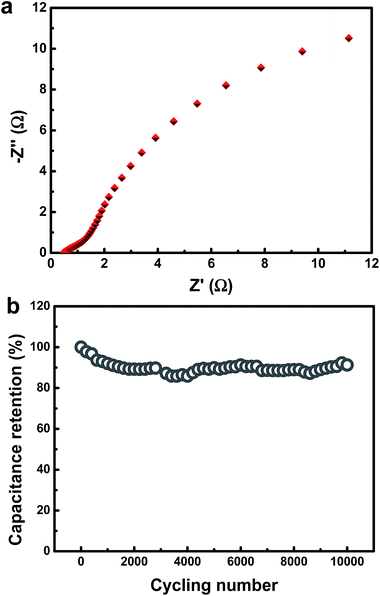 | ||
| Fig. 10 (a) Nyquist plot of the NiO//AC asymmetric supercapacitor. (b) Cycling performance of the asymmetric supercapacitor at 1 A g−1. | ||
In addition, two columnar NiO//AC supercapacitors with working area of 5 cm × 10 cm were assembled to reveal the potential of the NiO electrode for practical applications. A mini fan can be driven by two supercapacitors in series after charging for 1 min at 1 A (Fig. 11a and Video S1†). Furthermore, one supercapacitor can power a red LED for a long period of more than 270 min (Fig. 11b). These photographs and video vividly demonstrate the superior performance (high cell voltage, high energy and power density) of our NiO//AC supercapacitors, as well as the great potential for practical applications.
4. Conclusions
In summary, three-dimensional NiO nanopetals decorated nickel network can be fabricated through calcination of the anodized nickel foam with nickel oxalate nanostructures on the skeleton surface. The optimal calcination temperature has been determined to be 480 °C, considering the microstructure and pseudocapacitive properties of the obtained NiO electrodes. Free of any binder and conducting agent, the NiO electrode demonstrates a remarkable rate capability, and the specific capacitance could keep 82% of the highest value even though the current density is 25-fold enhanced. The NiO electrode also shows outstanding cycling performance, with good capacitance retention even after 30![[thin space (1/6-em)]](https://www.rsc.org/images/entities/char_2009.gif) 000 CV cycles. Furthermore, the assembled NiO//AC asymmetric supercapacitor presents excellent cycling stability (91.3% retention after 10
000 CV cycles. Furthermore, the assembled NiO//AC asymmetric supercapacitor presents excellent cycling stability (91.3% retention after 10![[thin space (1/6-em)]](https://www.rsc.org/images/entities/char_2009.gif) 000 cycles), and could power a mini fan as well as a commercial red LED for quite a long time. Both the unique nanopetal-like structure of NiO (active material) and three-dimensional network of nickel substrate (current collector), as well as their good interfacial bonding, account for the superior pseudocapacitive performance of the NiO electrode and NiO//AC asymmetric supercapacitor. The present findings could provide valuable information for fabrication of nanostructured metal oxides for high-performance supercapacitors.
000 cycles), and could power a mini fan as well as a commercial red LED for quite a long time. Both the unique nanopetal-like structure of NiO (active material) and three-dimensional network of nickel substrate (current collector), as well as their good interfacial bonding, account for the superior pseudocapacitive performance of the NiO electrode and NiO//AC asymmetric supercapacitor. The present findings could provide valuable information for fabrication of nanostructured metal oxides for high-performance supercapacitors.
Acknowledgements
The authors gratefully acknowledge financial support by National Natural Science Foundation of China (51371106), National Basic Research Program of China (973, 2012CB932800), Open Project of Shanghai Key Laboratory of Modern Metallurgy and Materials Processing (SELF-2011-02), Program for New Century Excellent Talents in University (MOE, NCET-11-0318), Specialized Research Fund for the Doctoral Program of Higher Education of China (20120131110017) and Young Tip-top Talent Support Project (the Organization Department of the Central Committee of the CPC). Z. Zhang acknowledges the support of the Alexander von Humboldt Foundation (Germany).Notes and references
- J. Park, E. Kang, S. U. Son, H. M. Park, M. K. Lee, J. Kim, K. W. Kim, H. J. Noh, J. H. Park, C. J. Bae, J. G. Park and T. Hyeon, Adv. Mater., 2005, 17, 429 CrossRef CAS.
- X. Xia, J. Tu, Y. Zhang, X. Wang, C. Gu, X.-B. Zhao and H. J. Fan, ACS Nano, 2012, 6, 5531 CrossRef CAS PubMed.
- L. Tao, J. Zai, K. Wang, Y. Wan, H. Zhang, C. Yu, Y. Xiao and X. Qian, RSC Adv., 2012, 2, 3410 RSC.
- L. Ji, Z. Lin, M. Alcoutlabi and X. Zhang, Energy Environ. Sci., 2011, 4, 2682 CAS.
- G. Zhang, W. Li, K. Xie, F. Yu and H. Huang, Adv. Funct. Mater., 2013, 23, 3675 CrossRef CAS.
- S. D. Tiwari and K. P. Rajeev, Thin Solid Films, 2006, 505, 113 CrossRef CAS PubMed.
- S. Mohan, P. Srivastava, S. N. Maheshwari, S. Sundar and R. Prakash, Analyst, 2011, 136, 2845 RSC.
- Y. Ding, Y. Wang, L. Zhang, H. Zhang and Y. Lei, J. Mater. Chem., 2012, 22, 980 RSC.
- D.-S. Kong, J.-M. Wang, H.-B. Shao, J.-Q. Zhan and C.-N. Cao, J. Alloys Compd., 2011, 509, 5611 CrossRef CAS PubMed.
- Z. Lu, Z. Chang, J. Liu and X. Sun, Nano Res., 2011, 4, 658 CrossRef CAS PubMed.
- Q. Lu, M. W. Lattanzi, Y. Chen, X. Kou, W. Li, X. Fan, K. M. Unruh, J. G. Chen and J. Q. Xiao, Angew. Chem., Int. Ed., 2011, 50, 6847 CrossRef CAS PubMed.
- X. Zhang, W. Shi, J. Zhu, W. Zhao, J. Ma, S. Mhaisalkar, T. Maria, Y. Yang, H. Zhang, H. Hng and Q. Yan, Nano Res., 2010, 3, 643 CrossRef CAS PubMed.
- S. Rakshit, S. Chall, S. S. Mati, A. Roychowdhury, S. P. Moulik and S. C. Bhattacharya, RSC Adv., 2013, 3, 6106 RSC.
- U. M. Patil, R. R. Salunkhe, K. V. Gurav and C. D. Lokhande, Appl. Surf. Sci., 2008, 255, 2603 CrossRef CAS PubMed.
- C.-Y. Cao, W. Guo, Z.-M. Cui, W.-G. Song and W. Cai, J. Mater. Chem., 2011, 21, 3204 RSC.
- L. Fan, L. Tang, H. Gong, Z. Yao and R. Guo, J. Mater. Chem., 2012, 22, 16376 RSC.
- S. Vijayakumar, S. Nagamuthu and G. Muralidharan, ACS Sustainable Chem. Eng., 2013, 1, 1110 CrossRef CAS.
- S. Zhao, H. Roberge, A. Yelon and T. Veres, J. Am. Chem. Soc., 2006, 128, 12352 CrossRef CAS PubMed.
- D. Gong, C. A. Grimes, O. K. Varghese, W. Hu, R. S. Singh, Z. Chen and E. C. Dickey, J. Mater. Res., 2001, 16, 3331 CrossRef CAS.
- W.-H. Chen, M.-Y. Lai, K.-T. Tsai, C.-Y. Liu and Y.-L. Wang, J. Mater. Chem. A, 2011, 115, 18406 CAS.
- J. E. Yoo and J. Choi, Electrochim. Acta, 2010, 55, 5142 CrossRef CAS PubMed.
- H. Tsuchiya and P. Schmuki, Electrochem. Commun., 2004, 6, 1131 CrossRef CAS PubMed.
- G. Cheng, J. Xu, C. Dong, W. Yang, T. Kou and Z. Zhang, J. Mater. Chem. A, 2014, 2, 17307 CAS.
- C. Zhou, Y. Zhang, Y. Li and J. Liu, Nano Lett., 2013, 13, 2078 CrossRef CAS PubMed.
- T.-Y. Wei, C.-H. Chen, H.-C. Chien, S.-Y. Lu and C.-C. Hu, Adv. Mater., 2010, 22, 347 CrossRef CAS PubMed.
- S. W. Oh, H. J. Bang, Y. C. Bae and Y.-K. Sun, J. Power Sources, 2007, 173, 502 CrossRef CAS PubMed.
- A. Seghiouer, J. Chevalet, A. Barhoun and F. Lantelme, J. Electroanal. Chem., 1998, 442, 113 CrossRef CAS.
- S. L. Medway, C. A. Lucas, A. Kowal, R. J. Nichols and D. Johnson, J. Electroanal. Chem., 2006, 587, 172 CrossRef CAS PubMed.
- S. C. Pang, M. A. Anderson and T. W. Chapman, J. Electrochem. Soc., 2000, 147, 444 CrossRef CAS PubMed.
- K.-W. Nam and K.-B. Kim, J. Electrochem. Soc., 2002, 149, A346 CrossRef CAS PubMed.
- U. M. Patil, K. V. Gurav, V. J. Fulari, C. D. Lokhande and O. S. Joo, J. Power Sources, 2009, 188, 338 CrossRef CAS PubMed.
- X. Wang, A. Sumboja, M. Lin, J. Yan and P. S. Lee, Nanoscale, 2012, 4, 7266 RSC.
- L. Mai, H. Li, Y. Zhao, L. Xu, X. Xu, Y. Luo, Z. Zhang, W. Ke, C. Niu and Q. Zhang, Sci. Rep., 2013, 3, 1718 Search PubMed.
- K. M. Hercule, Q. Wei, A. M. Khan, Y. Zhao, X. Tian and L. Mai, Nano Lett., 2013, 13, 5685 CrossRef CAS PubMed.
- S. Vijayakumar, S. Nagamuthu and G. Muralidharan, ACS Appl. Mater. Interfaces, 2013, 5, 2188 CAS.
- W. Li, Y. Bu, H. Jin, J. Wang, W. Zhang, S. Wang and J. Wang, Energy Fuels, 2013, 27, 6304 CrossRef CAS.
- C. Wu, S. Deng, H. Wang, Y. Sun, J. Liu and H. Yan, ACS Appl. Mater. Interfaces, 2014, 6, 1106 CAS.
- X. Xia, J. Tu, Y. Mai, R. Chen, X. Wang, C. Gu and X. Zhao, Chem.–Eur. J., 2011, 17, 10898 CrossRef CAS PubMed.
- J. Kang, L. Chen, Y. Hou, C. Li, T. Fujita, X. Lang, A. Hirata and M. Chen, Adv. Energy Mater., 2013, 3, 857 CrossRef CAS.
- H. B. Li, M. H. Yu, F. X. Wang, P. Liu, Y. Liang, J. Xiao, C. X. Wang, Y. X. Tong and G. W. Yang, Nat. Commun., 2013, 4, 1894 CrossRef CAS PubMed.
- H. Xia, B. Li and L. Lu, RSC Adv., 2014, 4, 11111 RSC.
- H. Xia, Y. S. Meng, G. Yuan, C. Cui and L. Lu, Electrochem. Solid-State Lett., 2012, 15, A60 CrossRef CAS PubMed.
- H. Xia, C. Hong, B. Li, B. Zhao, Z. Lin, M. Zheng, S. V. Savilov and S. M. Aldoshin, Adv. Funct. Mater., 2015, 25, 627 CrossRef CAS.
- J. Zhang, J. Jiang and X. S. Zhao, J. Phys. Chem. C, 2011, 115, 6448 CAS.
- J. Liu, J. Jiang, M. Bosman and H. J. Fan, J. Mater. Chem., 2012, 22, 2419 RSC.
- M. D. Stoller and R. S. Ruoff, Energy Environ. Sci., 2010, 3, 1294 CAS.
Footnote |
| † Electronic supplementary information (ESI) available. See DOI: 10.1039/c4ra15556d |
| This journal is © The Royal Society of Chemistry 2015 |

